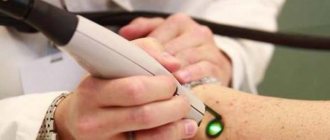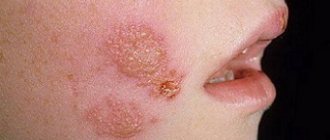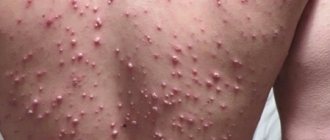Causes of toxic dermatitis
Toxic dermatitis can be caused by almost any drug, but the most common causes are antibiotics, nonsteroidal anti-inflammatory drugs, and drugs used to treat epilepsy. A drug rash appears a short time after starting to take the medication, and in most cases goes away immediately after discontinuation, but sometimes it takes two to three weeks. Some types of rashes are severe and may even be life-threatening and require hospital treatment, even if the patient is no longer taking the drug that caused the dermatitis.
Most often the reaction is caused by:
- Amoxicillin
- Biseptol
- Ampicillin
- Penicillin
- Blood products
- Cephalosporins
- Quinidine
- Gentamicin
- Diuretics
- Heparin
Cross-reactions occur between penicillins and cephalosporins, as well as between some anticonvulsants. For example, if a patient is allergic to ampicillin, cefazolin will also cause pathological changes in his skin.
Toxic skin damage is based on processes such as:
- Allergic reaction,
- Accumulation of toxic drugs in the dermis,
- Increased skin sensitivity to sunlight due to the influence of the drug,
- An interaction between two or more substances.
Drug rashes are more common in older people and affect women more than men. Other risk factors include:
- Taking antibiotics for a viral infection
- Weakening of the immune system due to some current disease, due to taking a drug,
- Malignant disease.
Diagnostics
To make a correct diagnosis, it is necessary to exclude other types of allergic reactions that appear on the skin, such as:
- lenticular psoriasis;
- lichen planus;
- eczema;
- allergic dermatitis;
- acne vulgaris;
- erythema, etc.
To exclude various diseases, an in vitro laboratory test is performed, although this analysis often gives false-positive or false-negative results.
Other methods for diagnosing toxicoderma include such types of studies as:
- taking a sample from the affected area to rule out infection;
- ultrasonography;
- electrocardiogram;
- provocative tests in vivo (after the allergy has been eliminated) (not performed for children);
- leukocyte tests;
- Analysis of urine;
- thrombocytopenic test;
- basophil test.
Symptoms of toxic dermatitis
Most rashes are symmetrical, that is, evenly distributed on both halves of the body. Also, this type of skin lesion does not cause any other symptoms. Only in some cases, a drug rash may be accompanied by itching or skin sensitivity.
- Eczematous rashes. This type is most common and accounts for 90% of all toxic skin processes. Its characteristic feature is small elements of a rash on reddened skin. They can be flat or raised. Sometimes you can see blistering and pus formation. Drugs that can cause this type of damage:
- Urticaria is the second most common type of drug rash. At its core, it is toxic-allergic dermatitis, which usually occurs in children, has a characteristic appearance, as shown in the photo, and treatment is aimed at eliminating the underlying cause and combating allergies. The rash is small pale pink bumps that can merge with each other, and itching is also noticeable. Main provoking drugs:
- Photosensitivity. Some medications make the skin especially sensitive to ultraviolet light. This can lead to an itchy sunburn if you go outside without adequate protection. This toxic dermatitis appears more often in adults, on open areas of the skin, on the face and hands, as shown in the photo. Medicines that affect photosensitivity:
- Erythroderma. In this condition, the entire surface of the body becomes red and itchy. Characteristically, there is pronounced peeling, the skin is hot to the touch, and the overall body temperature may rise, and chills occur. This occurs because epithelial cells die too quickly due to an inflammatory response. All drugs that cause a rash can also lead to erythroderma. This type of reaction can be dangerous and requires medical attention and immediate treatment. If left untreated, complications such as infection, loss of nutrients, dehydration, and heart failure may develop.
- Toxic epidermal necrolysis, or Stevens-Johnson syndrome. These two conditions differ only in the area of skin affected: if a large surface is affected, then it is epidermal necrolysis. The disease causes large, painful blisters to form that appear with slight pressure on the skin. They burst open, leaving open, extremely painful, weeping sores. Among the drugs that can cause this condition are sulfonamides, non-steroidal anti-inflammatory drugs, antiepileptic drugs, allopurinol and the HIV drug nevirapine. This disease is rare and dangerous; it is treated in a hospital.
- Rash while taking anticoagulants. Some blood thinners, such as warfarin, can lead to skin necrosis caused by anticoagulants. As a result, the deep layers of the skin die. This occurs when the patient begins to take large doses of the drug. Middle-aged women who are obese are more often affected by the condition. The first symptoms are pain and redness of the skin area. Then clear boundaries of the lesion are formed, it becomes dense, swells, and becomes covered with small (petechial) hemorrhages. The process progresses to the form of a necrotic ulcer, which slowly heals to form a scar. The condition can be dangerous; if you suspect it, you should immediately seek medical help.
| Penicillins (ampicillin, amoxicillin) |
| Sulfur-containing drugs (sulfonamides, sumatriptan, celecoxib, indapamide, furosemide) |
| Cephalosporins |
| Anticonvulsants (finlepsin, lamictal, topiramate) |
| Allopurinol |
| Non-steroidal anti-inflammatory drugs (ibuprofen, aspirin, diclofenac) |
| ACE inhibitors (captopril, enalapril, lisinopril) |
| Antibiotics, especially penicillin |
| Anesthetics |
| Tetracycline, doxycycline |
| Sulfonamides |
| Antifungal (griseofulvin) |
| Antihistamines (suprastin, tavegil) |
| Retinoids (isotretinoin) |
| Statins (atoris, crestor, vasilip) |
| Diuretics (indapamide, hypothiazide) |
Medicines
In addition to the listed drugs for local treatment, there are a number of other medications for systemic treatment, each of which performs its own function.
So, to remove toxins through the genitourinary system, I use the following drugs for oral administration:
- Furosemide;
- Dufolac;
- Portolac;
- Veroshpiron.
To suppress the aggressive immune process against allergens, the following is used intravenously:
- calcium gluconate solution;
- sodium thiosulfate solution;
- calcium gluconate (intramuscular).
Corticosteroid drugs for severe forms of toxicerma include:
- Descamethasone;
- Hydrocortisone;
- Prednisolone.
To restore damaged mucous membranes, use:
- Strepsils;
- Kamistad;
- Metrogil.
Toxic dermatitis in a child
The toxic type of erythema is dermatitis, which develops in full-term newborns (see photo) and is not a pathology. The rash usually appears in the first days and disappears within a week. This condition occurs in up to 50% of infants and affects the cheeks, chest, arms and legs, but never occurs on the palms and soles. The elements of the rash are red, small, raised, and may be filled with fluid. They resemble pimples full of pus, but in reality there is no pus or bacterial inflammation. This is not an infectious disease. Since no pathological symptoms occur and the rash goes away on its own, erythema toxicum of newborns does not require treatment. If, against the background of rashes, a child becomes restless, eats and sleeps poorly, cries, or develops a fever, it is necessary to consult a doctor, since such signs are not typical for this transient condition and may indicate a more serious illness.
Common toxicoderma
This form of the disease is more serious. Its symptoms can be life-threatening. Common toxicoderma is characterized by the following symptoms:
- the appearance of a rash;
- temperature increase;
- chills;
- digestive disorders.
If you stop taking the allergen immediately after the allergy appears, you can easily break the vicious circle. The symptoms of this type of disease are similar to other processes - urticaria, lichen Giber, erythema, lupus. Therefore, it is very important to contact qualified specialists.
Treatment of toxic dermatitis
In most cases, toxic dermatitis goes away on its own when the patient stops taking the medicine that caused it, so the question of how to treat it does not arise, no special therapy or diet is required. However, no medications can be canceled on their own, especially when it comes to serious conditions such as epilepsy, diabetes, and arterial hypertension. If a skin reaction occurs, consult a doctor. This is especially important when the patient is taking many different medications. By discontinuing it sequentially, the doctor will help detect the allergenic drug. Of course, if necessary, medications will be prescribed that will take over the functions of the canceled ones.
Sometimes the medicine that caused the reaction is vital for the patient and cannot be replaced by any other. Then, if it is only a rash, treatment may not be canceled, but antiallergic therapy may be prescribed and closely monitored in order to stop the development of complications in time. This should be done by a doctor; it is dangerous to continue taking an allergenic drug without medical supervision.
Treatment with medications
- Antihistamines. They help cope with itching, and first generation antihistamines such as suprastin and diphenhydramine are especially effective. With any allergy, the substance histamine is concentrated in the tissues, which irritates pain receptors, leading to itching. Drugs in this group block the release of histamine from cells.
- Ointments with glucocorticoids. The active substance, similar in structure to the hormones of the adrenal cortex, penetrates the dermis and suppresses the inflammatory response. Redness decreases, the rash fades and disappears, the itching goes away. Hello, long-term use of hormonal ointments can cause side effects, both local, in the form of skin atrophy, and general (increased blood pressure, blood sugar levels, obesity, osteoporosis). However, for toxic dermatitis they are used for a short course, it is quite safe.
- If there is no effect from antihistamines and local hormonal ointments, glucocorticosteroid hormones are prescribed in the form of tablets. They help quickly relieve general symptoms of inflammation.
- If a severe drug reaction occurs, such as erythroderma, toxic epidermal necrolysis, or warfarin necrosis, the condition is treated in a hospital under medical supervision. Sometimes the patient is admitted to a burn unit where facilities are in place to prevent infection. This is due to the skin losing its protective properties.
Fixed toxicoderma
Symptoms of fixed toxicoderma include the following:
- round or oval spots reaching a diameter of 3 centimeters;
- spots that have a brown tint on the 5th day from the moment of appearance;
- the bubble in the middle is an optional feature.
In order to stop the appearance of these rashes, you must stop taking the causative drug. In this case, after a week the skin rash will disappear without a trace. But if a person starts taking this medicine again, the rash will appear again. Moreover, in most cases they appear in the same places where they were before.
Sometimes a rash appears on the oral mucosa, but without inflammatory signs. In this situation, subjective symptoms are less pronounced. Often with toxicerma, disorders associated with the central nervous system are observed. Therefore, the following symptoms may appear:
- irritability;
- depression;
- insomnia;
- weakness;
- central itching of the skin.
Prevention of toxic dermatitis
An allergic reaction can occur from almost any medicine, although some are more likely to cause an allergic reaction. This means that when you take it for the first time in your life, you cannot predict whether a skin rash will develop or not. The only effective way to prevent toxic dermatitis - if it has already developed once in response to taking a drug - is not to take that drug again.
- It is important to carefully answer doctors’ questions and actively communicate your allergies at your appointment. The medical record must indicate intolerance. Be sure to also inform your dentist.
- If the reaction is severe, with angioedema or a sharp decrease in blood pressure (anaphylactic shock), it is advisable to wear a bracelet that reports this.
- In case of any ailment, it is necessary to follow the doctor’s recommendations and not self-medicate. For example, if a patient unknowingly begins to treat a viral infection with an antibiotic, the likelihood of developing toxic dermatitis is extremely high. A well-known symptom is that a rash appears when ampicillin is taken for infectious mononucleosis (kissing disease), suggesting a sore throat.
Traditional medicine
After prescribing treatment on an outpatient basis, procedures are added to the recovery process to help “calm” the affected areas on non-mucosal surfaces. To subside the itching, you can use a bath with the addition of grated oats.
This mixture is prepared as follows:
- Rub 200 g of oatmeal with your hands to a powder;
- pour 1 liter of water;
- simmer over low heat for 1 hour;
- add to bath.
In addition, decoctions and compresses from:
- chamomile;
- oak bark;
- St. John's wort;
- nettle;
- successions.
After taking a bath, apply baby cream to dry skin to moisturize the skin. The skin should not be allowed to dry out. To prevent the top layer from peeling off, creating new wounds, it should be lubricated with olive and peach essential oils.
Symptoms of the disease depending on the form of the disease
The severity of symptoms directly depends on the form of toxicoderma:
SPOTTED. Spotted toxicoderma is characterized by rashes in the form of limited spots on the skin. Most often, erythematous spots are observed; hemorrhagic (purpura) and pigmented spots are much less common. Erythematous rashes with this type of toxicoderma have the shape of a ring, roseola, dots that tend to merge into extensive erythema and are accompanied by itching, swelling and peeling. As a rule, the symptoms of this form occur without serious complications. To relieve negative symptoms, non-hormonal ointments are prescribed.
PAPULOUS. Such toxicoderma is accompanied by the appearance of pointed papules, which can be of different sizes. In some cases, when using anti-tuberculosis therapy, diabetes medications and vitamin therapy, the rash may resemble shingles. With complications of toxicoderma, the papules merge into single plaques. The patient notes excruciating itching and general deterioration of the condition. In this phase of the disease, increasing symptoms and subsequently complications may occur.
KNODY. This type of toxicoderma often develops under the influence of sulfonamide drugs, as well as iodine, various vaccines and bromine. Elements of the rash appear in the form of blisters (urticula), i.e. the blister does not have a cavity and rises above the surface of the skin due to swelling of the papillary layers of the dermis. Edema develops as a result of the influence of bradykinin and serotonin, which are mediators of the inflammatory process. As a rule, these diseases are monomorphic, so the elements of the rash are unstable and can disappear as quickly as possible and without a trace. As a rule, non-hormonal ointments and creams are prescribed.
In the case when edema of the dermis develops, increased lymphocytosis and an increased number of neutrophils are possible, which leads to general intoxication of the body and extensive skin lesions.
VESICULOSAL. Symptoms of this form of toxicerma are characterized by the appearance of vesicles surrounded by a halo of erythema. In rare cases, vesicular toxicoderma may be limited to only damage to the soles of the feet and palms. Most often it manifests itself as general dyshidrosis (a type of eczema). Severe toxicoderma is accompanied by vesiculoedematous erythroderma with edematous erythema, weeping, peeling, scab formation, possible swelling of the extremities, Quincke's edema, etc. The addition of secondary coccal flora and the formation of pustules are often noted.
PUSTULUS. Pustular toxicdermia most often appears after taking drugs with a high content of iodine, chlorine, bromine and fluorine, but the disease can progress under the influence of any dosage form.
The main element of pustular toxidermia is a pustule located in the very center of the inflamed spherical papule. Often, with toxicerma, rashes are localized on an area of the skin located near the sebaceous glands (chest, face, back). This is due to the release of halogenated (which can increase the toxic effect on the sebaceous glands) chemical compounds.
BULLOSIC. Bullous toxicoderma is most often observed after taking analgesic drugs, antibiotics, tranquilizers and sulfonamides. With this form of toxicoderma, rashes appear in the form of blisters with hyperemic edges (pemphigoid toxicoderma) or localized to a specific area of the skin (fixed toxicoderma). As a rule, fixed toxicoderma is characterized by an acute course. Despite drug therapy, sometimes fixed toxicoderma can drag on for a long period of time.
Bullous symptoms quite often accompany the severe stage of toxicoderma, manifesting themselves as multiform exudative erythema. Diagnosis of this form is difficult, since the patient’s condition is extremely serious. There is a painful headache, critical hyperthermia, dizziness (up to loss of consciousness). In extremely severe conditions, cerebral edema is possible.
What is toxicoderma?
Toxicoderma is an inflammatory process of the skin and mucous membranes; this disease is non-infectious.
Toxicoderma is one of the types of allergies in adults and children.
It occurs when an allergen—a chemical, medication, or food—enters the human body.
Irritants enter through the respiratory system, digestive organs and when the drug is administered intramuscularly or intravenously. A fairly common cause of toxicoderma is medications.
Diet
Toxidermia (photos, symptoms and treatment presented earlier), subject to a regressive process, stops if you exclude certain foods from the diet and follow a special diet.
In addition to the fact that it is necessary to avoid elements in the diet that cause repeated allergies, you should organize your diet in such a way as not to overload the body with heavy foods. You should also exclude foods and additives that irritate the mucous membranes.
It is necessary to refuse:
- alcohol;
- smoking;
- coffee drinks and tea;
- fried, smoked, canned foods;
- red meat;
- sour fruits;
- solid foods that take a long time to digest.
The diet should include:
- poultry and rabbit meat, best steamed or well boiled;
- pureed vegetable dishes;
- various greens;
- lean cooked or baked fish.
During the recovery process, you need to drink a lot of water, but without gas and soda, exclude strong teas, coffee and store-bought juices and drinks. You can use homemade compotes and vegetable juices.
Classification
Types of toxicerma in adult patients and children are classified depending on the method of penetration into the body of the substance that provokes the onset of the disease: by air, with food, as a result of injections or through the skin.
Medicinal (drug) toxicodermy
Medicinal toxidermy (also called “drug-induced”) is the most common of the existing types.
The cause of the disease is a variety of drugs (sulfonamides, corticosteroids, antibiotics, barbiturates, antihistamines) and even vitamins (most often groups B and PP).
Experts call glucose and saline solution absolutely harmless in this regard.
Women are more susceptible to the disease than men , because in addition to the drug risks, cosmetic ones are also added - representatives of the fair sex paint their eyelids, eyelashes, lips and, even having discovered the first symptoms of the disease, are interested (as evidenced by reviews on the Internet) whether it is possible to dye their hair in similar condition.
The answer to such a question can only be individual, from the attending physician, who knows the patient’s condition better than anyone.
Drug toxicoderma sometimes occurs due to one drug, sometimes due to several at once.
Treatment is especially difficult for chronically ill patients, who must not interrupt their prescribed medications, as this would pose a real threat to their condition.
If you are interested in the treatment of oral dermatitis on the face, as well as its symptoms and prevention, read our article.
An approximate diet menu for atopic dermatitis can be found here.
How to properly use Mustela baby shampoo for seborrheic crusts, read here:
Professional
This disease is diagnosed only in adult patients; it is observed in people working with any chemicals (compounds of nickel, chromium, cobalt).
The doctor’s recommendations in such situations usually boil down to a change in professional activity. Indeed, inflammatory processes, as a rule, stop after contact with irritant substances is eliminated.
Otherwise, even a cured patient will sooner or later face another relapse of the disease. The traditional method of treating this type of toxicoderma is non-hormonal therapy.
Food
Food toxicoderma (also called “alimentary”) is a painful reaction of the body to various foods (mainly those containing proteins). More than 120 such allergens have been identified today.
Sometimes the culprits of health problems are not the products themselves, but preservatives and dyes that “improve” their appearance, quality, extend shelf life.
If a patient is diagnosed with food toxicoderma, the question arises not only about treatment, but also about revising the principles of food selection and a new menu.
It is interesting that our smaller brothers living side by side with us also did not avoid similar problems.
Veterinarians detect nutritional dermatitis in some of them, which is caused by the dog’s individual sensitivity to a particular food, and also recommend switching the pet (for the purpose of recovery) to another food.
Autointoxication (autotoxic)
This type of disease is associated with the presence of any pathologies in the patient (gastrointestinal, pulmonary and others), when during their treatment the patient, along with the medications he is taking, receives a portion of substances that are allergens for him.
Metabolic processes in the body are disrupted. The medical history, unfortunately, is replenished with new pages. Autotoxic toxidermia often becomes chronic.











